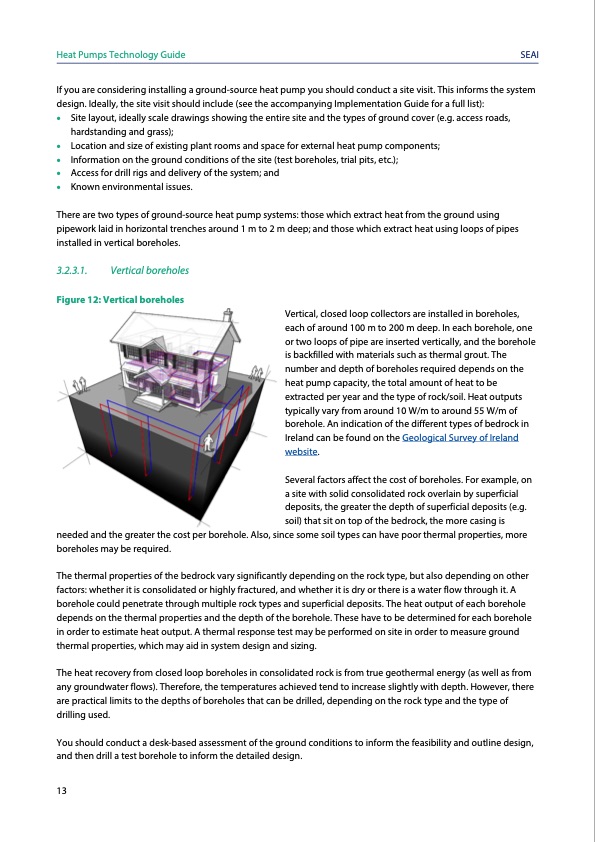
PDF Publication Title:
Text from PDF Page: 017
Heat Pumps Technology Guide SEAI If you are considering installing a ground-source heat pump you should conduct a site visit. This informs the system design. Ideally, the site visit should include (see the accompanying Implementation Guide for a full list): • Site layout, ideally scale drawings showing the entire site and the types of ground cover (e.g. access roads, hardstanding and grass); • Location and size of existing plant rooms and space for external heat pump components; • Information on the ground conditions of the site (test boreholes, trial pits, etc.); • Access for drill rigs and delivery of the system; and • Known environmental issues. There are two types of ground-source heat pump systems: those which extract heat from the ground using pipework laid in horizontal trenches around 1 m to 2 m deep; and those which extract heat using loops of pipes installed in vertical boreholes. 3.2.3.1. Vertical boreholes Figure 12: Vertical boreholes Vertical, closed loop collectors are installed in boreholes, each of around 100 m to 200 m deep. In each borehole, one or two loops of pipe are inserted vertically, and the borehole is backfilled with materials such as thermal grout. The number and depth of boreholes required depends on the heat pump capacity, the total amount of heat to be extracted per year and the type of rock/soil. Heat outputs typically vary from around 10 W/m to around 55 W/m of borehole. An indication of the different types of bedrock in Ireland can be found on the Geological Survey of Ireland website. Several factors affect the cost of boreholes. For example, on a site with solid consolidated rock overlain by superficial deposits, the greater the depth of superficial deposits (e.g. soil) that sit on top of the bedrock, the more casing is needed and the greater the cost per borehole. Also, since some soil types can have poor thermal properties, more boreholes may be required. The thermal properties of the bedrock vary significantly depending on the rock type, but also depending on other factors: whether it is consolidated or highly fractured, and whether it is dry or there is a water flow through it. A borehole could penetrate through multiple rock types and superficial deposits. The heat output of each borehole depends on the thermal properties and the depth of the borehole. These have to be determined for each borehole in order to estimate heat output. A thermal response test may be performed on site in order to measure ground thermal properties, which may aid in system design and sizing. The heat recovery from closed loop boreholes in consolidated rock is from true geothermal energy (as well as from any groundwater flows). Therefore, the temperatures achieved tend to increase slightly with depth. However, there are practical limits to the depths of boreholes that can be drilled, depending on the rock type and the type of drilling used. You should conduct a desk-based assessment of the ground conditions to inform the feasibility and outline design, and then drill a test borehole to inform the detailed design. 13PDF Image | Heat Pumps Technology Guide

PDF Search Title:
Heat Pumps Technology GuideOriginal File Name Searched:
Heat-Pump-Technology-Guide.pdfDIY PDF Search: Google It | Yahoo | Bing
CO2 Organic Rankine Cycle Experimenter Platform The supercritical CO2 phase change system is both a heat pump and organic rankine cycle which can be used for those purposes and as a supercritical extractor for advanced subcritical and supercritical extraction technology. Uses include producing nanoparticles, precious metal CO2 extraction, lithium battery recycling, and other applications... More Info
Heat Pumps CO2 ORC Heat Pump System Platform More Info
| CONTACT TEL: 608-238-6001 Email: greg@infinityturbine.com | RSS | AMP |